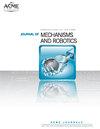计算六足机器人越障能力的解析可达体工作空间的实现
IF 2.2
4区 计算机科学
Q2 ENGINEERING, MECHANICAL
Journal of Mechanisms and Robotics-Transactions of the Asme
Pub Date : 2023-04-19
DOI:10.1115/1.4062353
引用次数: 0
摘要
在机构设计阶段准确计算最大过障碍能力,可以更好地确保制造的机器人原型满足预定指标。腿式机器人的越障任务是通过腿和身体的协同运动来实现的。可达工作空间约束了机器人足尖和身体的空间运动边界。足尖的可达工作空间是不变的,而可达身体工作空间的形状和体积随着支撑脚的不同而变化。身体运动被建模为六杆机构,可达身体工作空间是指位于六杆机构运动平台上的指定目标点的可达工作空间。与以往的工作不同,研究了计算移动平台外部目标点(称为外部目标点)的可达体工作空间的分析方法。考虑了支撑脚和小腿地面干扰对可达人体工作空间的影响。演示了支撑脚的选择、机器人身体和腿的协同运动序列,以及穿越沟渠和爬台阶的最大能力的确定,以实现分析可达身体工作空间。最后,仿真验证了理论分析的正确性。本文章由计算机程序翻译,如有差异,请以英文原文为准。
Implementing the analytical reachable body workspace for calculating the obstacle-crossing ability of a hexapod robot
Calculating the maximum obstacle-crossing ability accurately in the mechanism design stage can better ensure that the manufactured robot prototype meets the predefined indices. The obstacle-crossing task of the legged robot is achieved by the collaborative movement of the leg and body. The reachable workspace constrains the spatial movement boundary of the foot tip and the robot body. The reachable workspace of the foot tip is invariant, while the shape and volume of the reachable body workspace vary with the supporting footholds. The body movement is modeled as a six-bar mechanism, and the reachable body workspace means the reachable workspace of the specified target point located on the moving platform of the six-bar mechanism. Unlike the previous work, the analytical method of calculating the reachable body workspace for the target point outside the moving platform named the external target point is studied. The influence of supporting footholds and shank-ground interference on the reachable body workspace is considered. The selection of supporting footholds, the collaborative motion sequences of the robot body and legs, and the determination of the maximum ability for crossing a ditch and climbing a step are demonstrated for implementing the analytical reachable body workspace. Finally, simulations corroborate the correctness of the theoretical analysis.
求助全文
通过发布文献求助,成功后即可免费获取论文全文。
去求助
来源期刊

Journal of Mechanisms and Robotics-Transactions of the Asme
ENGINEERING, MECHANICAL-ROBOTICS
CiteScore
5.60
自引率
15.40%
发文量
131
审稿时长
4.5 months
期刊介绍:
Fundamental theory, algorithms, design, manufacture, and experimental validation for mechanisms and robots; Theoretical and applied kinematics; Mechanism synthesis and design; Analysis and design of robot manipulators, hands and legs, soft robotics, compliant mechanisms, origami and folded robots, printed robots, and haptic devices; Novel fabrication; Actuation and control techniques for mechanisms and robotics; Bio-inspired approaches to mechanism and robot design; Mechanics and design of micro- and nano-scale devices.
 求助内容:
求助内容: 应助结果提醒方式:
应助结果提醒方式:


